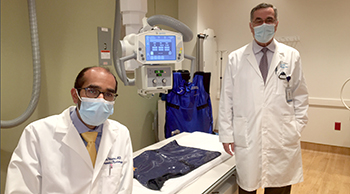Diagnostic Radiology discontinues use of lead aprons for general X-ray exams

Jay Pahade, MD, (left) YNHHS radiology medical director for Quality and Safety, and Adel Mustafa, PhD, Yale New Haven Hospital chief medical physicist, with a lead apron. Based on extensive research, Yale New Haven Health is discontinuing the use of these aprons for gonadal shielding during general X-ray exams.
New research into radiation exposure is prompting Yale New Haven Health System to discontinue its longstanding policy of using lead aprons to protect reproductive organs during certain exams.
The practice of draping a lead apron over a patient’s torso and pelvis to shield reproductive organs during imaging exams began in the 1950s. However, research conducted over the past decade on changes in imaging technology, combined with a better understanding of radiation’s effects, prompted radiology professionals to reassess the practice, according to Jay Pahade, MD, Yale New Haven Health radiology medical director for Quality and Safety.
“Medical imaging technology has made significant advances over the years, and uses much less radiation,” he said. “There is no evidence to suggest that routine X-rays taken today in a radiology department harm the reproductive organs.”
In fact, gonadal shielding might increase radiation to the patient, said Adel Mustafa, PhD, Yale New Haven Hospital chief medical physicist.
“Data show that the radiation dose may be higher when a lead shield is used, as it can increase the radiation emitted by the X-ray machine,” he said. “Also, if the shield is not properly placed, the technologist might have to repeat the X-ray.”
This policy change does not apply to lead shields used for other body parts, such as the breasts or the thyroid, in select radiology procedures. Gonadal shielding will continue to be used when needed during fluoroscopic exams.
“The current studies on this topic strictly focus on gonadal shielding during general X-ray exams,” said David Facchini, quality and safety manager, Radiology and Biomedical Imaging. “This will likely expand in the coming years as the practice change gets more traction.”
The gonadal shielding policy change has been implemented at YNHH and Bridgeport Hospital and will be implemented at other YNHHS sites over the next few months.
The American College of Radiology, American Association of Physicists in Medicine and National Council on Radiation Protection and Measurements support the change. A handful of other large U.S. health networks have already made the transition, with more expected across the globe over the next few years, Dr. Pahade said.

